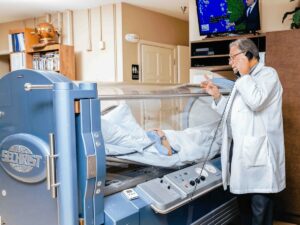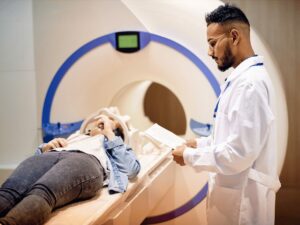Is hyperbaric oxygen therapy beneficial for brain health? The answer is yes, recent studies suggest it offers significant promise for enhancing neurological function.
As a specialist in hyperbaric technologies, I have spent years studying its impact on the human body, particularly the brain, equipping me with insights valuable to anyone exploring advanced healthcare solutions.
In this guide, you’ll gain insights into how hyperbaric oxygen therapy (HBOT) supports brain health, its applications for various neurological conditions, and the latest research findings.
Read on for a brain health breakthrough!
1. The Science Behind HBOT and Brain Function
Hyperbaric oxygen therapy (HBOT) involves breathing pure oxygen in a pressurized chamber. This process dramatically increases the amount of oxygen your blood can carry. An increase in blood oxygen temporarily restores normal levels of blood gases and tissue function to promote healing and fight infection. Amazing, isn’t it? This principle is especially beneficial for the brain, an organ highly sensitive to oxygen levels.
The brain relies on oxygen to perform its functions. By providing a higher concentration of oxygen to brain tissues, HBOT helps to revive cells that are on the verge of dying and stimulates the formation of new blood vessels. This is crucial for the recovery of brain functions following injury or in degenerative conditions. The increased oxygen supply can improve outcomes in patients with brain-related issues.

2. HBOT’s Mechanisms of Action on the Brain
Building on the foundation of how HBOT boosts brain function, it’s vital to understand the specific ways it impacts brain health. Here are the key mechanisms through which HBOT exerts its effects on the brain:
Neuroplasticity Stimulation
One of the most exciting aspects of HBOT is its ability to promote neuroplasticity, the brain’s capacity to form new neural connections. Here’s the interesting part, this mechanism is crucial for recovery from brain injuries and for improving cognitive functions. HBOT can stimulate the brain’s adaptability, aiding in learning and memory.
Angiogenesis Promotion
HBOT can also stimulate the process of angiogenesis, the formation of new blood vessels. This is particularly important in the brain, where new blood vessels can improve circulation and oxygen delivery to areas that need healing. Enhanced blood flow supports overall brain health and function.
Reduction in Oxidative Stress
Finally, HBOT helps to reduce oxidative stress, which is an imbalance between free radicals and antioxidants in the body. Oxidative stress can damage cells, including those in the brain. By increasing the levels of oxygen in the blood, HBOT can help counteract this imbalance, protecting brain cells from damage.
3. Clinical Applications of HBOT for Brain Conditions
Following our exploration of how HBOT impacts the brain, let’s delve into its practical applications for treating specific brain conditions. Here are some of the key areas where HBOT has shown promise:
Stroke Recovery
HBOT has been utilized to aid recovery in patients who have suffered a stroke. As per Bay Area Hyperbarics, 55% of stroke participants improved after HBOT treatment. By delivering a higher concentration of oxygen to the brain, it helps to improve neurological function. This therapy is particularly beneficial in the acute phase of stroke recovery, helping patients regain lost abilities more effectively.
Traumatic Brain Injury (TBI)
For individuals who have experienced a traumatic brain injury, HBOT can be a game-changer. For instance, it reduces swelling, minimizes inflammation, and encourages the repair of brain tissue. Patients often experience improvements in cognitive function, memory, and concentration following treatment.
Neurodegeneration
For individuals facing neurodegenerative diseases like Alzheimer’s and Parkinson’s, HBOT offers a beacon of hope. Oxygen-ark’s HBOT technology is specifically designed to deliver high concentrations of oxygen to the brain, enhancing cognitive functions. This therapy is gaining traction for its role in enhancing brain health and daily living activities among affected patients.
Post-Concussion Syndrome
HBOT has been identified as a beneficial treatment for post-concussion syndrome, a condition characterized by persistent symptoms following a concussion. For example, the therapy’s oxygenation effect can alleviate symptoms such as headaches and dizziness. How awesome is that? And patients often report a reduction in symptoms, highlighting HBOT’s efficacy in addressing post-concussion challenges.
4. Safety, Side Effects, and Considerations
After exploring HBOT’s applications for brain conditions, it’s equally crucial to address the therapy’s safety, possible side effects, and key considerations. Here are important aspects to bear in mind:
Safety
- Pre-screening for Medical Conditions: Patients should undergo a thorough medical evaluation to identify any conditions that may contraindicate HBOT, such as untreated pneumothorax.
- Ensuring Proper Chamber Operation: Regular maintenance and checks of Oxygen-ark’s hyperbaric chamber are essential to prevent malfunctions and secure the safety of both patients and operators.
- Training for Emergency Situations: Staff should be well-trained in handling emergencies, including chamber decompression and fire safety protocols.
- Monitoring Oxygen Levels: Continuous monitoring of oxygen levels within the chamber is vital to avoid oxygen toxicity, ensuring a safe treatment environment.
Effects
- Temporary Myopia: Patients may experience short-term nearsightedness due to oxygen effects on lens refraction, which typically reverses after treatment.
- Middle Ear Barotrauma: Due to pressure changes, individuals might encounter ear pain or damage without proper ear equalization techniques.
- Oxygen Toxicity: Excessive exposure can lead to oxygen toxicity, affecting the central nervous system and lungs, but is rare with proper monitoring.
- Fatigue: Some patients report feeling tired after sessions, which is generally temporary and subsides with rest.
Considerations
- Evaluate Patient Eligibility: Before offering HBOT, assess if a patient’s condition could benefit from this treatment. Not all brain conditions are suitable for HBOT, so a thorough evaluation is necessary.
- Stay Informed on the Latest Research: Keep updated on the latest research and developments in HBOT to offer the most current treatments. This ensures patients receive care based on the latest scientific findings.
- Secure Comprehensive Training: Staff providing HBOT should be well-trained and certified. Comprehensive training guarantees the safe and effective administration of the therapy.
- Monitor and Adjust Treatment: Closely monitor patients’ responses to HBOT and be prepared to adjust treatment plans as necessary. Personalized treatment approaches can enhance the therapy’s effectiveness.

5. HBOT vs. Other Brain Therapy Modalities
Following our discussion on safety, side effects, and considerations, let’s compare HBOT with other brain therapy modalities to provide a clearer picture of its unique benefits and limitations. Here are some comparative insights:
HBOT vs. Electroconvulsive Therapy
- HBOT: This therapy involves breathing pure oxygen in a pressurized chamber, which enhances the body’s natural healing processes. It’s generally considered safe for treating conditions like traumatic brain injury.
- Electroconvulsive Therapy (ECT): ECT is a psychiatric treatment where seizures are electrically induced to provide relief from severe mental illnesses. The problem is, that it’s effective but causes memory loss.
HBOT vs. Vagus Nerve Stimulation
- HBOT: By increasing oxygen saturation in the body and brain, HBOT can promote neuroplasticity and aid in the recovery of brain functions without directly interacting with the nervous system’s structure.
- Vagus Nerve Stimulation (VNS): VNS involves implanting a device that stimulates the vagus nerve with electrical impulses, treating depression. It directly affects the brain’s function through the nervous system.
HBOT vs. Magnetic Seizure Therapy
- HBOT: The therapy’s approach is to saturate the body with oxygen to improve healing and cognitive functions, useful in a wide range of neurological conditions without requiring anesthesia.
- Magnetic Seizure Therapy (MST): MST is a newer form of therapy that induces seizures using magnetic fields which is less invasive. It’s primarily researched for treating severe depression and schizophrenia.
| Aspect |
Hyperbaric Oxygen Therapy (HBOT) |
Magnetic Seizure Therapy (MST) |
| Approach |
Involves saturating the body with oxygen under increased atmospheric pressure, enhancing healing and cognitive functions. |
Utilizes magnetic fields to induce seizures in a less invasive manner. |
| Application |
Effective in various neurological conditions, offering non-invasive treatment. |
Primarily studied for treating severe depression and schizophrenia. |
| Safety |
Generally considered safe, with rare side effects like barotrauma or oxygen toxicity, which are closely monitored. |
Still under study for safety concerns, particularly regarding the risk of seizures and their management. |
| Treatment Duration |
Sessions typically last between 60 to 90 minutes, and the total duration of therapy varies depending on the condition being treated. |
Treatment duration varies but generally involves a series of sessions over several weeks or months. |
| Cost-effectiveness |
May be costly due to equipment and facility requirements, although its long-term benefits may justify the investment. |
Costs are influenced by factors like equipment, clinician expertise, and insurance coverage, potentially affecting accessibility. |
6. Practical Advice for Those Considering HBOT
After comparing HBOT with other brain therapy modalities, it’s clear that it offers a unique approach to treating brain conditions. If you’re considering HBOT, here are some tips to keep in mind:
#1 Assess Needs
Before integrating HBOT into your offerings, conduct a thorough assessment of your client base’s needs. Understand that HBOT is particularly beneficial for conditions like chronic wounds, certain types of infections, and brain injuries. Analyzing your current services and identifying gaps that HBOT can fill will guarantee it complements your existing treatments effectively.
#2 Infrastructure Requirements
Implementing HBOT requires specific infrastructure, including space for the chambers and modifications to accommodate these units safely. Each chamber demands a considerable amount of space and access to medical-grade oxygen. Ensuring your facility can handle these requirements, without disrupting other services is essential.
#3 Market Differentiation
Finally, consider how HBOT will differentiate your business in a competitive healthcare market. HBOT offers a unique selling proposition, especially if you’re among the first in your area to offer it. Developing a marketing strategy that highlights the benefits of HBOT services can attract new clients and position your business as a leader in innovative therapeutic solutions.
Dive Deeper Into Our Resources
Looking for more diverse product options? Browse through our handpicked selections:
Still haven’t found what you’re looking for? Don’t hesitate to contact us. We’re available around the clock to assist you.
Conclusion
Hyperbaric Oxygen Therapy (HBOT) has shown promising benefits for brain health, from enhancing cognitive functions to aiding in the recovery of brain injuries. This guide has illuminated the science, safety, and practicalities of HBOT, offering valuable insights for those considering this therapy.
If your business is exploring the effectiveness of HBOT for brain health, Oxygen-ark can provide the expertise and solutions you need. Contact us today and let’s discuss your inquiries.


